You're about to make a delicious lemon cake that balances tanginess and sweetness. Start by preheating your oven to 350°F. Mix 1¾ cups of flour, 1 cup of sugar, and a pinch of salt in one bowl. In another, combine ½ cup softened unsalted butter, 2 large eggs, 1 cup buttermilk, the juice of fresh lemons, and a bit of lemon zest. Gradually mix the wet ingredients into the dry ones, then pour the batter into a greased 9-inch round cake pan. Bake for 25-30 minutes or until a toothpick comes out clean. There's even more to explore for a perfect finish!
Key Takeaways
- Use 1 ¾ to 2 cups of all-purpose flour and 1 to 1 ½ cups of sugar for the cake structure and sweetness.
- Combine ½ cup softened unsalted butter, 2 to 3 eggs, and 1 cup buttermilk for moisture and binding.
- Preheat the oven to 350°F (175°C) and bake the cake for 25-35 minutes, checking for doneness with a toothpick.
- Incorporate fresh lemon juice and zest for tanginess and aromatic quality in the batter.
- Decorate with a lemon glaze, fresh berries, or a dusting of powdered sugar for added visual appeal.
History
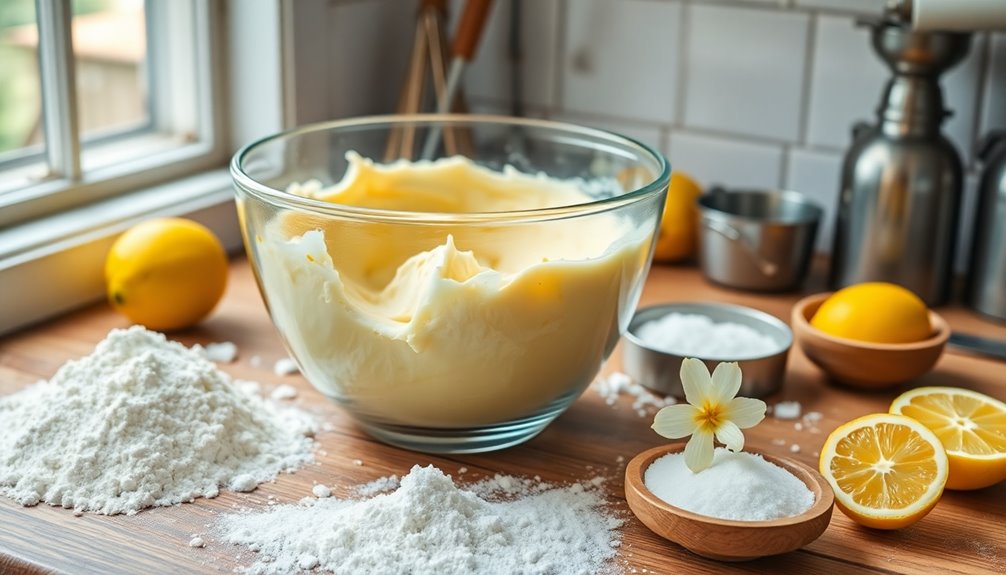
Lemon cake has a rich history that dates back to the Middle Ages, when sugar was a luxury and lemon was prized for its flavor and preservative qualities.
Bakers often used lemons to enhance their cakes, creating a delightful contrast to the sweetness of sugar. Over the centuries, as sugar became more accessible, lemon cake recipes evolved, incorporating new ingredients and techniques.
By the 19th century, lemon cake had gained popularity, appearing in cookbooks and becoming a staple at celebrations.
You might find that lemon cake symbolizes joy and refreshment, making it a favorite for gatherings and special occasions.
As you explore its history, you'll appreciate the blend of culture, innovation, and tradition that shaped this beloved dessert.
Recipe
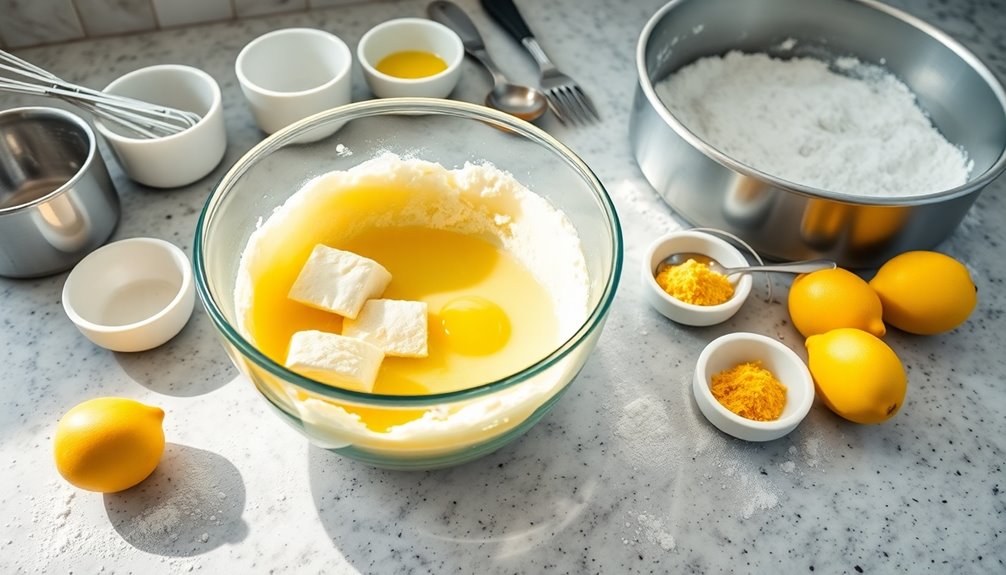
Lemon cake is a delightful dessert that offers a perfect balance of sweetness and tartness, making it a favorite for any occasion. This light and fluffy cake is infused with fresh lemon juice and zest, which gives it a revitalizing flavor that's particularly enjoyable during warmer months.
Whether you're celebrating a birthday, hosting a tea party, or simply craving something sweet, this lemon cake recipe is sure to impress your guests and satisfy your taste buds.
The beauty of lemon cake lies not only in its flavor but also in its simplicity. With just a few basic ingredients, you can create a moist and tender cake that's bursting with citrusy goodness.
The addition of lemon glaze or frosting can elevate this cake to new heights, adding an extra layer of sweetness and enhancing its charming appearance. So, roll up your sleeves and get ready to bake a delicious lemon cake that will brighten up any day!
Ingredients:
- 1 ¾ cups all-purpose flour
- 1 cup granulated sugar
- ½ cup unsalted butter, softened
- 2 large eggs
- 1 cup buttermilk
- 2 tablespoons fresh lemon juice
- Zest of 1 lemon
- 2 teaspoons baking powder
- ½ teaspoon baking soda
- ½ teaspoon salt
- Optional: powdered sugar for dusting or lemon glaze
Instructions:
Preheat your oven to 350°F (175°C) and grease a 9-inch round cake pan.
In a large mixing bowl, cream together the softened butter and granulated sugar until light and fluffy. Add the eggs one at a time, mixing well after each addition. Gradually stir in the buttermilk, fresh lemon juice, and lemon zest.
In a separate bowl, whisk together the flour, baking powder, baking soda, and salt. Slowly incorporate the dry ingredients into the wet mixture until just combined.
Pour the batter into the prepared cake pan and bake for 25-30 minutes or until a toothpick inserted in the center comes out clean. Allow the cake to cool in the pan for 10 minutes before transferring it to a wire rack to cool completely.
Extra Tips:
For an even more intense lemon flavor, you can add a tablespoon of lemon extract to the batter.
Make sure to zest the lemon before juicing it, as it's easier to grate that way. If you prefer a sweeter cake, consider drizzling a lemon glaze made from powdered sugar and lemon juice over the cooled cake.
Storing the cake in an airtight container will help maintain its moisture, and it can be enjoyed for several days after baking!
Cooking Steps

Now that you've got your ingredients ready, it's time to jump into the cooking steps.
Start by preheating your oven to 350°F, then mix your dry ingredients together.
After that, you'll gradually add the wet ingredients for a smooth batter.
Step 1. Preheat Oven to 350°F
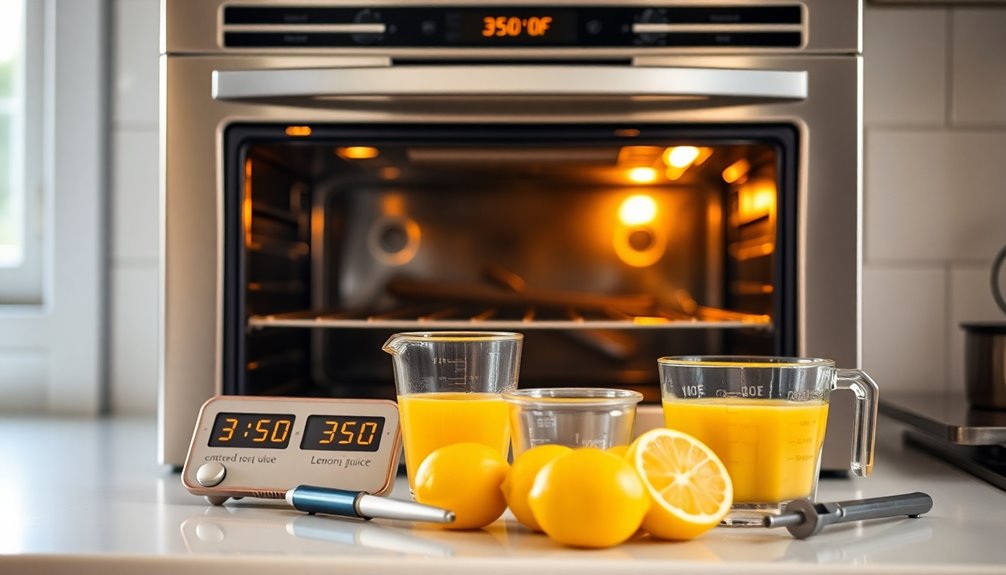
To kick off your lemon cake adventure, preheat your oven to 350°F. This step is essential, as a properly heated oven guarantees your cake bakes evenly and rises beautifully.
While the oven warms up, you can gather your ingredients and prepare your baking pans. Make sure the oven rack is positioned in the center for ideal heat distribution.
If you've got a conventional oven, it might take about 10-15 minutes to reach the desired temperature, so be patient. You can use an oven thermometer to double-check that it's accurate.
Once the oven beeps or indicates it's ready, you'll be set to move on to the next steps in your delicious lemon cake journey! Happy baking!
Step 2. Mix Dry Ingredients Together
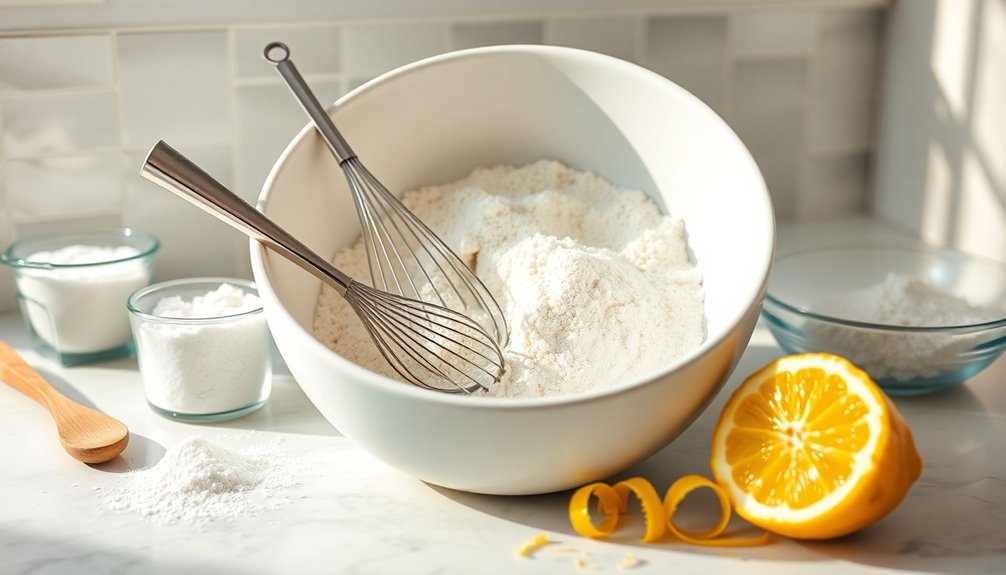
Before you immerse yourself in mixing the dry ingredients, gather your flour, baking powder, salt, and sugar.
Once you have everything ready, grab a mixing bowl. Start by sifting the flour and baking powder together. This helps to aerate the mixture, ensuring a light and fluffy cake.
Next, add the salt and sugar to the bowl. Using a whisk, gently combine all the dry ingredients. Make sure there are no lumps, as this will affect the texture of your cake.
Continue whisking until everything's evenly mixed. This step is essential for a well-balanced flavor throughout your lemon cake.
Once you're satisfied with the consistency, set the bowl aside for the next stage of your baking adventure.
Step 3. Add Wet Ingredients Gradually
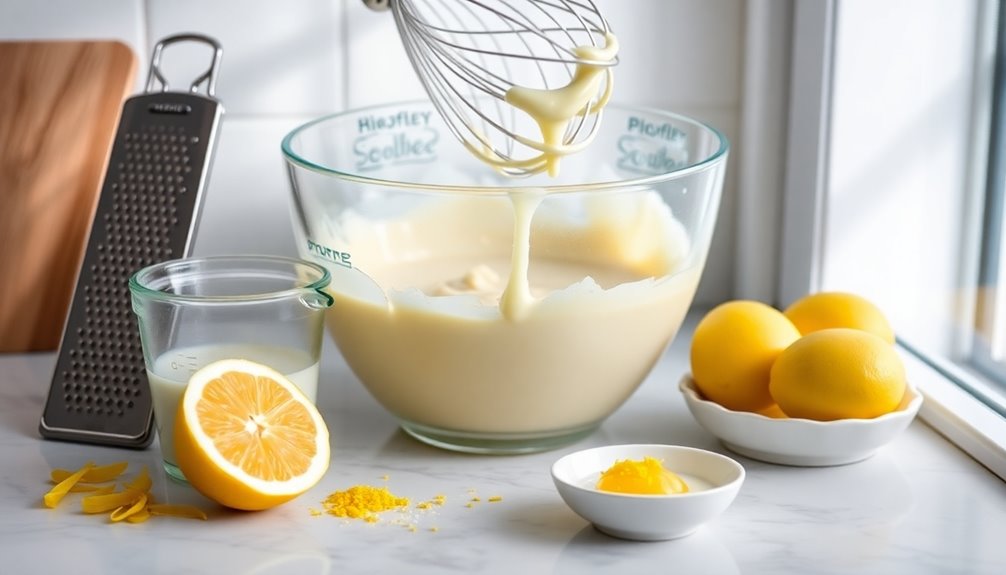
As you prepare to add the wet ingredients, make sure your butter is softened and your eggs are at room temperature for ideal mixing.
Begin by creaming the softened butter in your mixing bowl until it's light and fluffy. Next, crack the eggs into a separate bowl, whisk them gently, and then incorporate them gradually into the creamed butter. This helps maintain a smooth texture.
Once the eggs are blended, slowly pour in your milk and lemon juice, mixing continuously. This gradual addition prevents the batter from curdling and guarantees a uniform consistency.
Remember to scrape down the sides of the bowl to capture any ingredients that cling. Your mixture should now be creamy and ready for the next step!
Step 4. Fold in Lemon Zest
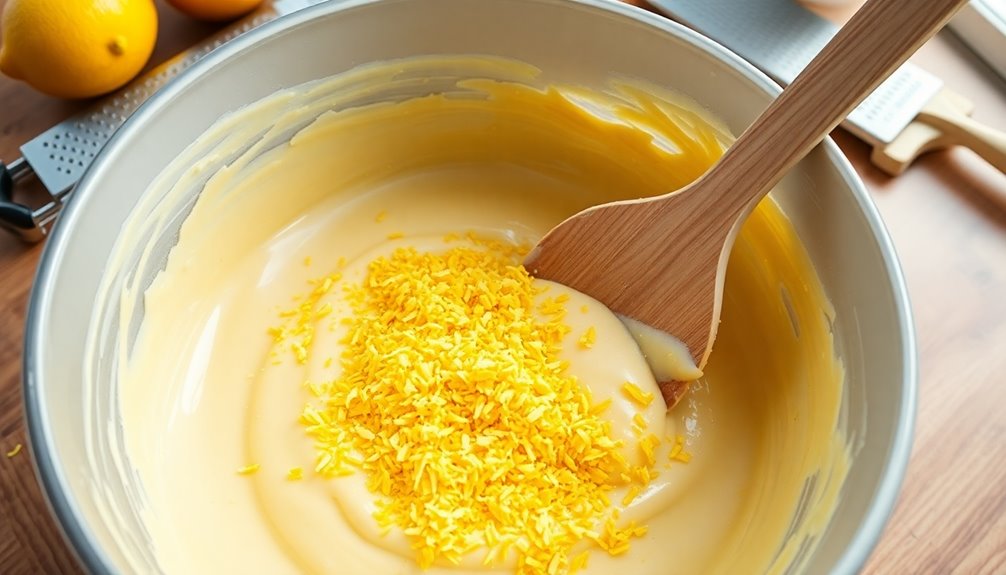
Once your wet ingredients are thoroughly combined, it's time to fold in the lemon zest.
Take your fresh lemon zest and sprinkle it over the mixture. Using a spatula, gently lift and fold the batter from the bottom to the top. Be careful not to overmix; you want to incorporate the zest without deflating the batter.
This step adds a burst of citrus flavor and a lovely aroma to your cake. Keep folding until you see the zest evenly distributed throughout the mixture.
Remember, the goal is to maintain the lightness of your batter while ensuring every bite is infused with that bright lemony taste.
Once you're satisfied, you're ready to move on to the next step!
Step 5. Pour Batter Into Pan
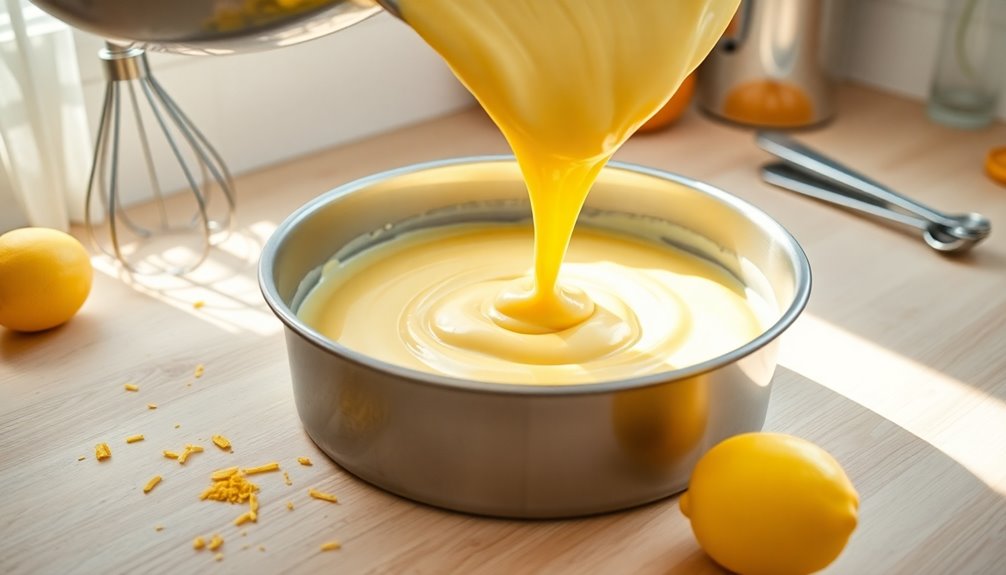
Carefully pour the batter into your prepared cake pan, ensuring an even distribution. Use a spatula to scrape the bowl and get every last bit of that delicious batter.
Once you've poured it in, gently shake the pan from side to side to level the surface; this helps prevent air bubbles from forming. If you notice any bubbles, you can tap the pan lightly on the counter to release them.
Now, it's time to smooth the top with the spatula, making sure it's uniform. Preheat your oven to the specified temperature while your batter settles.
Once you're satisfied with the batter's surface, slide the pan into the oven and bake according to your recipe's instructions. Enjoy the sweet anticipation!
Final Thoughts

When you take a moment to savor your homemade lemon cake, you'll appreciate not just the tangy sweetness but also the effort you put into creating it.
Each bite reflects your dedication and love for baking. This cake isn't just a dessert; it's a celebration of flavors that can brighten any occasion.
Whether it's for a birthday, a gathering, or a simple treat for yourself, you've crafted something special. Don't forget to share it with friends and family; their joy will make the experience even more rewarding.
Remember, baking is a journey. Each attempt teaches you something new, so don't hesitate to experiment with flavors or decorations.
Enjoy your delicious creation, and happy baking!
Frequently Asked Questions
Can I Use Bottled Lemon Juice Instead of Fresh Lemons?
You can definitely use bottled lemon juice instead of fresh lemons, but keep in mind that the flavor mightn't be as vibrant.
Bottled juice often contains preservatives that can alter the taste slightly. If you're in a pinch, it's a convenient substitute, but fresh lemons usually provide a brighter, more natural flavor.
If you decide to go with bottled juice, just measure carefully to match the intensity you want in your dish.
What Is the Best Frosting for Lemon Cake?
When you're choosing the best frosting, consider a tangy cream cheese frosting or a light lemon buttercream. Both options complement the cake's citrus flavor beautifully.
Cream cheese frosting adds a rich, creamy texture, while lemon buttercream offers an invigorating zing. You could also try a simple whipped cream frosting for a lighter touch.
Ultimately, it's up to your taste preference, so don't hesitate to experiment until you find the perfect match!
How Can I Make a Gluten-Free Lemon Cake?
To make a gluten-free lemon cake, start by using a gluten-free flour blend instead of regular flour.
You'll need to adjust the liquid ingredients slightly, as gluten-free flours can absorb more moisture.
Add fresh lemon juice and zest for that zesty flavor.
Make sure to incorporate baking powder to help the cake rise.
Don't forget to check for cross-contamination if you're sensitive to gluten.
Enjoy your deliciously light and tangy creation!
Can I Substitute Olive Oil for Butter in This Recipe?
Absolutely, you can substitute olive oil for butter in many recipes!
Just keep in mind that olive oil has a distinct flavor, which may alter the final taste a bit. Use about ¾ of the amount of olive oil compared to butter, since it's more liquid.
This swap can also make your dish a bit healthier, as olive oil is rich in healthy fats.
Enjoy experimenting with this substitution!
How Should I Store Leftover Lemon Cake?
To store leftover cake, you'll want to keep it fresh for as long as possible.
First, let it cool completely. Then, wrap it tightly in plastic wrap or place it in an airtight container.
If you have a lot of leftovers, consider slicing the cake for easier access.
You can store it at room temperature for a couple of days or in the fridge for up to a week.
Enjoy your sweet treat!










